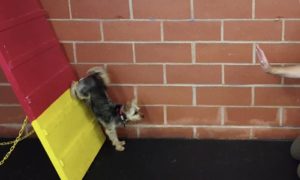My dog training students often ask, “What is the difference between Stay and Wait?” It’s a good question. After all, they have the same hand signal and “Wait,” like “Stay”, is often used to keep a dog where she is when you gave the cue.
When I first started training dogs, I didn’t fully appreciate the many uses of a solid “Wait”, and I would answer, “Wait” is short term and is usually given when a dog is moving and is meant to prevent her from passing a boundary, whereas “Stay” means for your dog to hold that position until you return to her and release her.
While the above definition may be valid, I now see that a strong “Wait” is so much more than that. Let me count the ways.
1. Safety at any boundary, not just ones you approach while moving. Inside of a crate. Inside of a car. Includes going into a building or leaving an elevator, and you’re not sure what is immediately out of your view. This is a very common use, and is the one also commonly used as (and confused with) a temporary “stay”.
2. Food Manners. Impulse Control. Over time it prevents the food thief.
3. For training manners around access to places like beds, couches, and any other special area of the house. Really, anywhere where you want to condition your dog to look to you for access (and guidance), rather than to just have a lack of structure and become a bossy wild child.
4. To respect the “bubble” of space around humans when greeting, and to calm down before being able to “Go say hi” to visitors. This can prevent injuries to small children and elders.
5. For building duration in tricks and also helpful behaviors you’ve taught your dog. For example, I taught my dog to walk backwards up a wall and also to bow his head in prayer. Getting Rover into those positions was easy, but getting him to hold them was a bit harder. He’s come to learn that “Wait” just means, “Freeze, right there!” regardless the position. As per helpful behaviors, say you’ve taught your dog to roll to her side and you want to be able to check her for fleas (essentially, to hold a “play dead”), a “Wait” cue can be given to a trained dog. Or to get a dog to stand still while toweling him off after a bath.
In summary, while Wait and Stay can certainly be used somewhat interchangeably when it comes to keeping a dog stationary for short periods of time, you’d definitely want to preserve Stay as a strong separate cue for when you really need a longer duration behavior. And as I listed above, “Wait” is so much more than just a short, more relaxed Stay.




